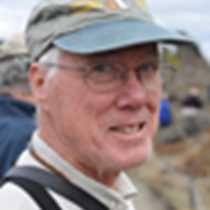Fox Creek, Idaho Inlet, Chichagof Island, Alaska
Sometime in early spring a brown bear walked along the beach near Fox Creek, along the shore of Idaho Inlet. Newly awaken from his winter sleep, he was seeking something -anything! - to eat. Perhaps he would find the carcass of a winter-killed deer, perhaps a banquet of invertebrates in the intertidal zone, but the tide was high and no food was to be found there. Our bear turned away from the beach, following a trail left by generations of bears before. Where the trail narrowed between two hemlock trees he stopped and sniffed. He stood on his hind legs, leaned against the tree, and reached as high as he could; he even stood on an exposed root to reach even higher, and he scratched his sharp claws down the tree. In so doing, he left a sign to other bears who might pass this way: he was here and he was big, and he was prepared to assert his dominance. (Unless, of course, it was a female who might bear his young; she was most welcome!) Our bear then continued his amble. In the deep moss of the forest floor he placed his feet in exactly the spots where countless bears before him had tread, and so he added to the trail. Why did he do so? We really don’t know. Perhaps the wide spacing of the large paw prints tells a smaller bear that he had better proceed with caution! Perhaps each passing bear seeks to cover the scent left by the previous. Our bear continued a short distance to enter a wet seep full of Western skunk cabbage. This plant is the first to begin growth in spring. Using his long claws and enormous strength the bear dug into the cold, wet ground to get at roots and rhizomes, which he feasted on. Afterward, he left a large pile of bear scat along the trail, and then moved on. Countless evidence of the passage of this bear awaited our visit to Fox Creek. We walked along trails first made by bears. We looked for berries on the same blueberry and salmonberry bushes that bears have harvested, and we gazed down at pink salmon swimming up the very same streams in which the previous generation had spawned two years before. Berries and the fatty tissues of salmon are important food for bears as they fatten in preparation for the next winter. Uneaten parts of fish remain to fertilize the forest, their nutrients brought from the sea contributing to the productivity of the Temperate Rain Forest. It is this bounty in a nearly undisturbed environment that makes the ABC Islands of Southeastern Alaska – Admiralty, Baranof, and Chichagof – so rich in wildlife and home of the largest populations of brown bears.
Sometime in early spring a brown bear walked along the beach near Fox Creek, along the shore of Idaho Inlet. Newly awaken from his winter sleep, he was seeking something -anything! - to eat. Perhaps he would find the carcass of a winter-killed deer, perhaps a banquet of invertebrates in the intertidal zone, but the tide was high and no food was to be found there. Our bear turned away from the beach, following a trail left by generations of bears before. Where the trail narrowed between two hemlock trees he stopped and sniffed. He stood on his hind legs, leaned against the tree, and reached as high as he could; he even stood on an exposed root to reach even higher, and he scratched his sharp claws down the tree. In so doing, he left a sign to other bears who might pass this way: he was here and he was big, and he was prepared to assert his dominance. (Unless, of course, it was a female who might bear his young; she was most welcome!) Our bear then continued his amble. In the deep moss of the forest floor he placed his feet in exactly the spots where countless bears before him had tread, and so he added to the trail. Why did he do so? We really don’t know. Perhaps the wide spacing of the large paw prints tells a smaller bear that he had better proceed with caution! Perhaps each passing bear seeks to cover the scent left by the previous. Our bear continued a short distance to enter a wet seep full of Western skunk cabbage. This plant is the first to begin growth in spring. Using his long claws and enormous strength the bear dug into the cold, wet ground to get at roots and rhizomes, which he feasted on. Afterward, he left a large pile of bear scat along the trail, and then moved on. Countless evidence of the passage of this bear awaited our visit to Fox Creek. We walked along trails first made by bears. We looked for berries on the same blueberry and salmonberry bushes that bears have harvested, and we gazed down at pink salmon swimming up the very same streams in which the previous generation had spawned two years before. Berries and the fatty tissues of salmon are important food for bears as they fatten in preparation for the next winter. Uneaten parts of fish remain to fertilize the forest, their nutrients brought from the sea contributing to the productivity of the Temperate Rain Forest. It is this bounty in a nearly undisturbed environment that makes the ABC Islands of Southeastern Alaska – Admiralty, Baranof, and Chichagof – so rich in wildlife and home of the largest populations of brown bears.




